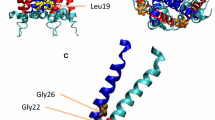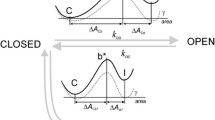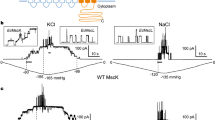Abstract
Gating transition of the mechanosensitive channel of large conductance (MscL) represents a good example of important biological processes that are difficult to describe using atomistic simulations due to the large (submicron) length scale and long (millisecond) time scale. Here we develop a novel computational framework that tightly couples continuum mechanics with continuum solvation models to study the detailed gating behavior of E. coli-MscL. The components of protein molecules are modeled by continuum elements that properly describe their shape, material properties and physicochemical features (e.g., charge distribution). The lipid membrane is modeled as a three-layer material in which the lipid head group and tail regions are treated separately, taking into account the fact that fluidic lipid bilayers do not bear shear stress. Coupling between mechanical and chemical responses of the channel is realized by an iterative integration of continuum mechanics (CM) modeling and continuum solvation (CS) computation. Compared to previous continuum mechanics studies, the present model is capable of capturing the most essential features of the gating process in a much more realistic fashion: due mainly to the apolar solvation contribution, the membrane tension for full opening of MscL is reduced substantially to the experimental measured range. Moreover, the pore size stabilizes constantly during gating because of the intricate interactions of the multiple components of the system, implying the mechanism for sub-conducting states of MscL gating. A significant fraction (\(\sim \)2/3) of the gating membrane strain is required to reach the first sub-conducting state of our model, which is featured with a relative conductance of 0.115 to the fully opened state. These trends agree well with experimental observations. We anticipate that the coupled CM/CS modeling framework is uniquely suited for the analysis of many biomolecules and their assemblies under external mechanical stimuli.









Similar content being viewed by others
References
ABAQUS (2011) ABAQUS 6.11 User’s Mannual. ABAQUS Inc. Pawtucket, RI
Ajouz B, Berrier C, Besnard M, Martinac B, Ghazi A (2000) Contributions of the different extramembranous domains of the mechanosensitive ion channel MscL to its response to membrane tension. J Biol Chem 275:1015–1022
Anishkin A, Akitake B, Kamaraju K, Chiang C, Sukharev S (2010) Hydration properties of mechanosensitive channel pores define the energetics of gating. J Phys Condens Matter 22:454120
Anishkin A, Chiang CS, Sukharev S (2005) Gain-of-function mutations reveal expanded intermediate states and a sequential action of two gates in MscL. J Gen Physiol 125:155–170. doi:10.1085/jgp.200409118
Anishkin A, Kung C (2005) Microbial mechanosensation. Curr Opin Neurobiol 15:397–405. doi:10.1016/j.conb.2005.06.002
Argudo D, Bethel NP, Marcoline FV, Grabe M (2016) Continuum descriptions of membranes and their interaction with proteins: towards chemically accurate models. Biochim Biophys Acta. doi:10.1016/j.bbamem.2016.02.003
Baker NA, Sept D, Joseph S, Holst MJ, McCammon JA (2001) Electrostatics of nanosystems: application to microtubules and the ribosome. Proc Natl Acad Sci U S A 98:10037–10041. doi:10.1073/pnas.181342398
Bass RB, Strop P, Barclay M, Rees DC (2002) Crystal structure of Escherichia coli MscS, a voltage-modulated and mechanosensitive channel. Science 298:1582–1587
Beckstein O, Biggin PC, Sansom MSP (2001) A hydrophobic gating mechanism for nanopores. J Phys Chem B 105:12902–12905. doi:10.1021/Jp012233y
Beckstein O, Sansom MS (2004) The influence of geometry, surface character, and flexibility on the permeation of ions and water through biological pores. Phys Biol 1:42–52. doi:10.1088/1478-3967/1/1/005
Berrier C, Besnard M, Ajouz B, Coulombe A, Ghazi A (1996) Multiple mechanosensitive ion channels from Escherichia coli, activated at different thresholds of applied pressure. J Membrane Biol 151:175–187. doi:10.1007/s002329900068
Binder H, Gawrisch K (2001) Effect of unsaturated lipid chains on dimensions, molecular order and hydration of membranes. J Phys Chem B 105:12378–12390
Blount P, Schroeder MJ, Kung C (1997) Mutations in a bacterial mechanosensitive channel change the cellular response to osmotic stress. J Biol Chem 272:32150–32157
Booth IR, Edwards MD, Black S, Schumann U, Miller S (2007) Mechanosensitive channels in bacteria: signs of closure? Nat Rev Microbiol 5:431–440. doi:10.1038/nrmicro1659
Cao GX, Chen X (2006) Mechanisms of nanoindentation on single-walled carbon nanotubes: the effect of nanotube length. J Mater Res 21:1048–1070. doi:10.1557/Jmr.2006.0128
Chacon E, Tarazona P, Bresme F (2015) A computer simulation approach to quantify the true area and true area compressibility modulus of biological membranes. J Chem Phys 143:034706. doi:10.1063/1.4926938
Chang G, Spencer RH, Lee AT, Barclay MT, Rees DC (1998) Structure of the MscL homolog from Mycobacterium tuberculosis: a gated mechanosensitive ion channel. Science 282:2220–2226
Chen X, Cui Q, Tang Y, Yoo J, Yethiraj A (2008) Gating mechanisms of mechanosensitive channels of large conductance, I: a continuum mechanics-based hierarchical framework. Biophys J 95:563–580. doi:10.1529/biophysj.107.128488
Chen X, Tang Y, Cao G (2006) Elastic properties of carbon nanotubes in the radial direction. Proc Inst Mech Eng Part N J Nanoeng Nanosyst 219:73–88. doi:10.1243/17403499jnn39
Chiang CS, Anishkin A, Sukharev S (2004) Gating of the large mechanosensitive channel in situ: estimation of the spatial scale of the transition from channel population responses. Biophys J 86:2846–2861. doi:10.1016/S0006-3495(04)74337-4
Clapham DE (2003) TRP channels as cellular sensors. Nature 426:517–524. doi:10.1038/Nature02196
Corry B, Hurst AC, Pal P, Nomura T, Rigby P, Martinac B (2010) An improved open-channel structure of MscL determined from FRET confocal microscopy and simulation. J Gen Physiol 136:483–494. doi:10.1085/jgp.200910376
Davis ME, Mccammon JA (1990) Electrostatics in biomolecular structure and dynamics. Chem Rev 90:509–521. doi:10.1021/Cr00101a005
Deng Y, Sun M, Shaevitz JW (2011) Direct measurement of cell wall stress stiffening and turgor pressure in live bacterial cells. Phys Rev Lett 107:158101
Deplazes E, Louhivuori M, Jayatilaka D, Marrink SJ, Corry B (2012) Structural investigation of MscL gating using experimental data and coarse grained MD simulations. PLoS Comput Biol 8:e1002683
Dhaka A, Viswanath V, Patapoutian A (2006) Trp ion channels and temperature sensation. Ann Rev Neurosci 29:135–161. doi:10.1146/annurev.neuro.29.051605.112958
Dror RO, Dirks RM, Grossman JP, Xu H, Shaw DE (2012) Biomolecular simulation: a computational microscope for molecular biology. Annu Rev Biophys 41:429–452. doi:10.1146/annurev-biophys-042910-155245
Geeves MA, Holmes KC (1999) Structural mechanism of muscle contraction. Annu Rev Biochem 68:687–728. doi:10.1146/annurev.biochem.68.1.687
Geeves MA, Holmes KC (2005) The molecular mechanism of muscle contraction. Adv Protein Chem 71:161–193. doi:10.1016/S0065-3233(04)71005-0
Gullingsrud J, Schulten K (2003) Gating of MscL studied by steered molecular dynamics. Biophys J 85:2087–2099. doi:10.1016/S0006-3495(03)74637-2
Gullingsrud J, Schulten K (2004) Lipid bilayer pressure profiles and mechanosensitive channel gating. Biophys J 86:3496–3509
Hamill OP, Martinac B (2001) Molecular basis of mechanotransduction in living cells. Physiol Rev 81:685–740
Haswell ES, Phillips R, Rees DC (2011) Mechanosensitive channels: What can they do and how do they do it? Structure 19:1356–1369. doi:10.1016/j.str.2011.09.005
Hayakawa K, Tatsumi H, Sokabe M (2008) Actin stress fibers transmit and focus force to activate mechanosensitive channels. J Cell Sci 121:496–503. doi:10.1242/jcs.022053
Heckbert PS, Garland M (1999) Optimal triangulation and quadric-based surface simplification. Comp Geom-Theor Appl 14:49–65. doi:10.1016/S0925-7721(99)00030-9
Honig B, Nicholls A (1995) Classical electrostatics in biology and chemistry. Science 268:1144–1149
Im W, Beglov D, Roux B (1998) Continuum solvation model: computation of electrostatic forces from numerical solutions to the Poisson–Boltzmann equation. Comput Phys Commun 111:59–75. doi:10.1016/S0010-4655(98)00016-2
Ingber DE (2006) Cellular mechanotransduction: putting all the pieces together again. Faseb J 20:811–827. doi:10.1096/fj.05-5424rev
Ingolfsson HI, Lopez CA, Uusitalo JJ, de Jong DH, Gopal SM, Periole X, Marrink SJ (2014) The power of coarse graining in biomolecular simulations. Wiley Interdiscip Rev Comput Mol Sci 4:225–248. doi:10.1002/wcms.1169
Iscla I, Blount P (2012) Sensing and responding to membrane tension: the bacterial MscL channel as a model system. Biophys J 103:169–174. doi:10.1016/j.bpj.2012.06.021
Iscla I, Wray R, Blount P (2008) On the structure of the N-terminal domain of the MscL channel: helical bundle or membrane interface. Biophys J 95:2283–2291
Jeon J, Voth GA (2008) Gating of the mechanosensitive channel protein MscL: the interplay of membrane and protein. Biophys J 94:3497–3511. doi:10.1529/biophysj.107.109850
Karplus M, Kuriyan J (2005) Molecular dynamics and protein function. Proc Natl Acad Sci U S A 102:6679–6685. doi:10.1073/pnas.0408930102
Klepeis JL, Lindorff-Larsen K, Dror RO, Shaw DE (2009) Long-timescale molecular dynamics simulations of protein structure and function. Curr Opin Struct Biol 19:120–127. doi:10.1016/j.sbi.2009.03.004
Krishtal O (2003) The ASICs: signaling molecules? Modulators? Trends Neurosci 26:477–483. doi:10.1016/S0166-2236(03)00210-8
Levin G, Blount P (2004) Cysteine scanning of MscL transmembrane domains reveals residues critical for mechanosensitive channel gating. Biophys J 86:2862–2870. doi:10.1016/S0006-3495(04)74338-6
Louhivuori M, Risselada HJ, van der Giessen E, Marrink SJ (2010) Release of content through mechano-sensitive gates in pressurized liposomes. Proc Natl Acad Sci USA 107:19856–19860
Ma L, Yethiraj A, Chen X, Cui Q (2009) A computational framework for mechanical response of macromolecules: application to the salt concentration dependence of DNA bendability. Biophys J 96:3543–3554. doi:10.1016/j.bpj.2009.01.047
Markin VS, Sachs F (2004) Thermodynamics of mechanosensitivity. Phys Biol 1:110–124. doi:10.1088/1478-3967/1/2/007
Marrink SJ, Risselada HJ, Yefimov S, Tieleman DP, de Vries AH (2007) The MARTINI force field: coarse grained model for biomolecular simulations. J Phys Chem B 111:7812–7824. doi:10.1021/jp071097f
Marrink SJ, Tieleman DP (2013) Perspective on the Martini model. Chem Soc Rev 42:6801–6822. doi:10.1039/c3cs60093a
Martinac B (2004) Mechanosensitive ion channels: molecules of mechanotransduction. J Cell Sci 117:2449–2460. doi:10.1242/jcs.01232
Martinac B, Kloda A (2003) Evolutionary origins of mechanosensitive ion channels. Prog Biophys Mol Biol 82:11–24
Moe P, Blount P (2005) Assessment of potential stimuli for mechano-dependent gating of MscL: effects of pressure, tension, and lipid headgroups. Biochemistry 44:12239–12244. doi:10.1021/bi0509649
Monticelli L, Kandasamy SK, Periole X, Larson RG, Tieleman DP, Marrink SJ (2008) The MARTINI coarse-grained force field: extension to proteins. J Chem Theory Comput 4:819–834. doi:10.1021/Ct700324x
Pantano A, Boyce MC, Parks DM (2003) Nonlinear structural mechanics based modeling of carbon nanotube deformation. Phys Rev Lett 91:145504
Perozo E, Cortes DM, Sompornpisut P, Kloda A, Martinac B (2002a) Open channel structure of MscL and the gating mechanism of mechanosensitive channels. Nature 418:942–948. doi:10.1038/nature00992
Perozo E, Kloda A, Cortes DM, Martinac B (2002b) Physical principles underlying the transduction of bilayer deformation forces during mechanosensitive channel gating. Nat Struct Biol 9:696–703. doi:10.1038/nsb827
Phillips R, Ursell T, Wiggins P, Sens P (2009) Emerging roles for lipids in shaping membrane-protein function. Nature 459:379–385. doi:10.1038/nature08147
Powl AM, East JM, Lee AG (2003) Lipid-protein interactions studied by introduction of a tryptophan residue: the mechanosensitive channel MscL. Biochemistry 42:14306–14317
Powl AM, East JM, Lee AG (2005a) Heterogeneity in the binding of lipid molecules to the surface of a membrane protein: hot spots for anionic lipids on the mechanosensitive channel of large conductance MscL and effects on conformation. Biochemistry 44:5873–5883
Powl AM, East JM, Lee AG (2008) Importance of direct interactions with lipids for the function of the mechanosensitive channel MscL\({\dagger }\). Biochemistry 47:12175–12184
Powl AM, Wright JN, East JM, Lee AG (2005b) Identification of the hydrophobic thickness of a membrane protein using fluorescence spectroscopy: studies with the mechanosensitive channel MscL, 1. Biochemistry 44:5713–5721
Praprotnik M, Site LD, Kremer K (2008) Multiscale simulation of soft matter: from scale bridging to adaptive resolution. Annu Rev Phys Chem 59:545–571. doi:10.1146/annurev.physchem.59.032607.093707
Sackin H (1995) Mechanosensitive channels. Annu Rev Physiol 57:333–353. doi:10.1146/annurev.ph.57.030195.002001
Saimi Y et al (1992) Patch clamp studies of microbial ion channels. Methods Enzymol 207:681–691
Sanner MF, Olson AJ, Spehner JC (1996) Reduced surface: an efficient way to compute molecular surfaces. Biopolymers 38:305–320
Saunders MG, Voth GA (2012) Coarse-graining of multiprotein assemblies. Curr Opin Struct Biol 22:144–150. doi:10.1016/j.sbi.2012.01.003
Sawada Y, Murase M, Sokabe M (2012) The gating mechanism of the bacterial mechanosensitive channel. MscL revealed by molecular dynamics simulations: from tension sensing to channel opening channels (Austin) 6:317–331. doi:10.4161/chan.21895
Scarpa F, Adhikari S, Gil AJ, Remillat C (2010) The bending of single layer graphene sheets: the lattice versus continuum approach. Nanotechnology 21:125702. doi:10.1088/0957-4484/21/12/125702
Shi Q, Izvekov S, Voth GA (2006) Mixed atomistic and coarse-grained molecular dynamics: simulation of a membrane-bound ion channel. J Phys Chem B 110:15045–15048. doi:10.1021/jp062700h
Shinoda W, DeVane R, Klein ML (2012) Computer simulation studies of self-assembling macromolecules. Curr Opin Struct Biol 22:175–186. doi:10.1016/j.sbi.2012.01.011
Snow CD, Sorin EJ, Rhee YM, Pande VS (2005) How well can simulation predict protein folding kinetics and thermodynamics? Annu Rev Biophys Biomol Struct 34:43–69. doi:10.1146/annurev.biophys.34.040204.144447
Steinbacher S, Bass R, Strop P, Rees DC (2007) Structures of the prokaryotic mechanosensitive channels MscL and MscS. Mechanosensit Ion Channels Part A 58:1–24. doi:10.1016/S1063-5823(06)58001-9
Sukharev S, Anishkin A (2004) Mechanosensitive channels: What can we learn from ‘simple’ model systems? Trends Neurosci 27:345–351. doi:10.1016/j.tins.2004.04.006
Sukharev S, Betanzos M, Chiang CS, Guy HR (2001a) The gating mechanism of the large mechanosensitive channel MscL. Nature 409:720–724. doi:10.1038/35055559
Sukharev S, Corey DP (2004) Mechanosensitive channels: multiplicity of families and gating paradigms. Sci Signal 2004:re4
Sukharev S, Durell SR, Guy HR (2001b) Structural models of the MscL gating mechanism. Biophys J 81:917–936. doi:10.1016/S0006-3495(01)75751-7
Sukharev SI, Blount P, Martinac B, Kung C (1997) Mechanosensitive channels of Escherichia coli: the MscL gene, protein, and activities. Annu Rev Physiol 59:633–657. doi:10.1146/annurev.physiol.59.1.633
Sukharev SI, Sigurdson WJ, Kung C, Sachs F (1999) Energetic and spatial parameters for gating of the bacterial large conductance mechanosensitive channel. MscL J Gen Physiol 113:525–540
Tang Y, Cao G, Chen X, Yoo J, Yethiraj A, Cui Q (2006) A finite element framework for studying the mechanical response of macromolecules: application to the gating of the mechanosensitive channel MscL. Biophys J 91:1248–1263. doi:10.1529/biophysj.106.085985
Tang Y, Yoo J, Yethiraj A, Cui Q, Chen X (2008) Gating mechanisms of mechanosensitive channels of large conductance, II: systematic study of conformational transitions. Biophys J 95:581–596. doi:10.1529/biophysj.107.128496
Torres-Sánchez A, Vanegas JM, Arroyo M (2015) Examining the mechanical equilibrium of microscopic stresses in molecular simulations. Phys Rev Lett 114:258102
Tsai IJ, Liu ZW, Rayment J, Norman C, McKinley A, Martinac B (2005) The role of the periplasmic loop residue glutamine 65 for MscL mechanosensitivity. Eur Biophys J EBJ 34:403–412. doi:10.1007/s00249-005-0476-x
Tserpes KI, Papanikos P (2009) Continuum modeling of carbon nanotube-based super-structures. Compos Struct 91:131–137. doi:10.1016/j.compstruct.2009.04.039
Turner MS, Sens P (2004) Gating-by-tilt of mechanically sensitive membrane channels. Phys Rev Lett 93:118103
Van Der Spoel D, Lindahl E, Hess B, Groenhof G, Mark AE, Berendsen HJ (2005) GROMACS: fast, flexible, and free. J Comput Chem 26:1701–1718. doi:10.1002/jcc.20291
Vanegas JM, Arroyo M (2014) Force transduction and lipid binding in MscL: a continuum-molecular approach. PloS one 9:e113947
Vanegas JM, Torres-Sánchez A, Arroyo M (2014) Importance of force decomposition for local stress calculations in biomembrane molecular simulations. J Chem Theory Comput 10:691–702
Venable RM, Brown FL, Pastor RW (2015) Mechanical properties of lipid bilayers from molecular dynamics simulation. Chem Phys Lipids 192:60–74. doi:10.1016/j.chemphyslip.2015.07.014
Wagoner JA, Baker NA (2006) Assessing implicit models for nonpolar mean solvation forces: the importance of dispersion and volume terms. Proc Natl Acad Sci 103:8331–8336. doi:10.1073/pnas.0600118103
Wang HC, Thampatty BP (2006) An introductory review of cell mechanobiology. Biomech Model Mechanobiol 5:1–16
Wang Y et al (2014) Single molecule FRET reveals pore size and opening mechanism of a mechano-sensitive ion channel. Elife 3:e01834. doi:10.7554/eLife.01834
Wiggins P, Phillips R (2004) Analytic models for mechanotransduction: gating a mechanosensitive channel. Proc Natl Acad Sci USA 101:4071–4076. doi:10.1073/pnas.0307804101
Wisdom KM, Delp SL, Kuhl E (2014) Use it or lose it: multiscale skeletal muscle adaptation to mechanical stimuli. Biomech Model Mechanobiol 14:195–215
Yefimov S, van der Giessen E, Onck PR, Marrink SJ (2008) Mechanosensitive membrane channels in action. Biophys J 94:2994–3002. doi:10.1529/biophysj.107.119966
Yesylevskyy SO, Schafer LV, Sengupta D, Marrink SJ (2010) Polarizable water model for the coarse-grained MARTINI force field. PLoS Comput Biol 6:e1000810. doi:10.1371/journal.pcbi.1000810
Zeng Y, Ai KY, Teo SK, Chiam KH (2011) A three-dimensional random network model of the cytoskeleton and its role in mechanotransduction and nucleus deformation. Biomech Model Mechanobiol 11:49–59
Acknowledgments
X.C. acknowledges additional support from National Natural Science Foundation of China (11172231, 11372241 and 11572238), Advanced Research Projects Agency-Energy (DE-AR0000396) and Air Force Office of Scientific Research (FA9550-12-1-0159).
Author information
Authors and Affiliations
Corresponding author
Rights and permissions
About this article
Cite this article
Zhu, L., Wu, J., Liu, L. et al. Gating mechanism of mechanosensitive channel of large conductance: a coupled continuum mechanical-continuum solvation approach. Biomech Model Mechanobiol 15, 1557–1576 (2016). https://doi.org/10.1007/s10237-016-0783-4
Received:
Accepted:
Published:
Issue Date:
DOI: https://doi.org/10.1007/s10237-016-0783-4




